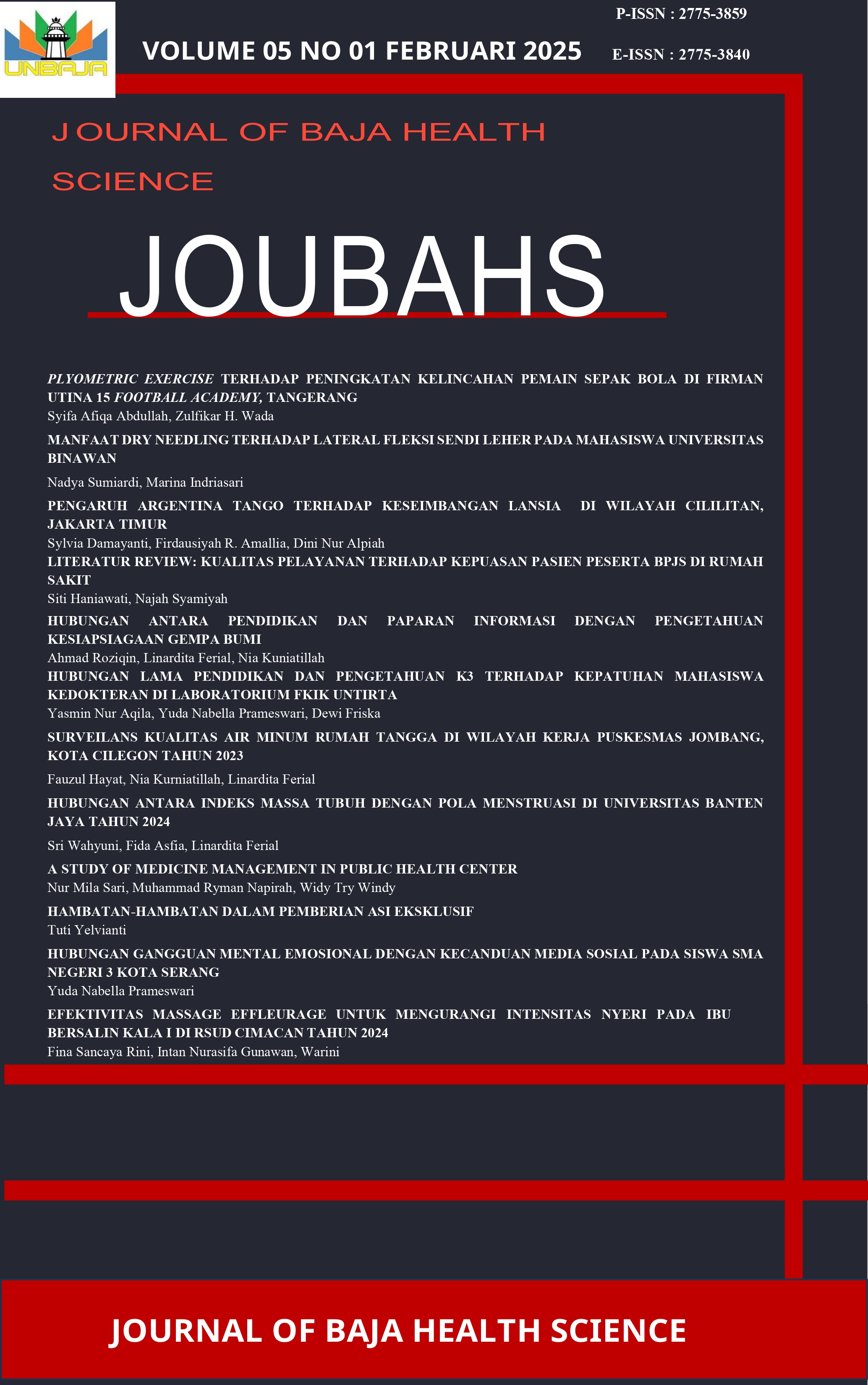HUBUNGAN GANGGUAN MENTAL EMOSIONAL DENGAN KECANDUAN MEDIA SOSIAL PADA SISWA SMA NEGERI 3 KOTA SERANG
DOI:
https://doi.org/10.47080/joubahs.v5i1.3903Keywords:
BSMAS, Gangguan Mental Emosional, Kecanduan Media Sosial, Remaja, SRQ20Abstract
Tingkat kecanduan media sosial saat ini semakin meningkat, terutama di kalangan remaja. Sekitar 75% individu yang kecanduan internet dipengaruhi oleh masalah dalam hubungan sosial mereka. Salah satu faktor yang berperan adalah gangguan mental emosional. Penelitian ini bertujuan untuk mengetahui hubungan antara gangguan mental emosional dengan kecanduan media sosial pada siswa SMA Negeri 3 Kota Serang. Data dikumpulkan menggunakan kuesioner sosiodemografi, Bergen Social Media Addiction Scale (BSMAS), dan Self Reporting Questionnaire 20 (SRQ20). Hasil penelitian adalah mayoritas subjek memiliki gangguan mental emosional normal (76,47%) dan tingkat kecanduan media sosial normal (67,06%). Sementara yang terindikasi gangguan emosional adalah 23,53% dan kecanduan media social alert adalah 32,94%. Analisis menunjukkan adanya hubungan signifikan antara gangguan mental emosional dan kecanduan media sosial (p-value = 0,009, OR=2,61, 95% CI: 1,259–5,414). Hal ini menunjukkan bahwa gangguan mental emosional dapat berkontribusi terhadap peningkatan risiko kecanduan media sosial.
References
Ani Petrosyan. (2024). Countries With The Largest Digital Populations In The World As Of January 2024. Statista. Retrieved.
Aprilia, R., Sriati, A., & Hendrawati, S. (2020). Tingkat Kecanduan Media Sosial pada Remaja. Journal of Nursing Care, 3(1). https://doi.org/10.24198/jnc.v3i1.26928
Asosiasi Penyelenggara Jasa Internet Indonesia. (2024). APJII Jumlah Pengguna Internet Indonesia Tembus 221 Juta Orang.
Chemnad, K., Aziz, M., Abdelmoneium, A. O., Al-Harahsheh, S., Baghdady, A., Al Motawaa, F. Y., Alsayed Hassan, D., & Ali, R. (2023). Adolescents’ Internet addiction: Does it all begin with their environment? Child and Adolescent Psychiatry and Mental Health, 17(1), 87. https://doi.org/10.1186/s13034-023-00626-7
Choudhury, M., & Ali, A. (2020). Comparative study social media addiction among youth: a gender comparison. The International Journal of Indian Psychology, 8(3), 2349–3429. https://doi.org/10.25215/0803.084
Chung, T. W. H., Sum, S. M. Y., & Chan, M. W. L. (2019). Adolescent Internet Addiction in Hong Kong: Prevalence, Psychosocial Correlates, and Prevention. Journal of Adolescent Health, 64(6), S34–S43. https://doi.org/10.1016/j.jadohealth.2018.12.016
Daulay, N., Harahap, A. C. P., & Sinaga, M. H. P. (2022). The role of guidance and counseling service in helping students with academic stress. ProGCouns: Journal of Professionals in Guidance and Counseling, 3(2), 78–86. https://doi.org/10.21831/progcouns.v3i2.53821
Fortuna, D. D. (2024). The Influence of Difficulties in Emotion Regulation on Internet Addiction towards Students Who Use Online Gambling Sites and Applications Pengaruh Kesulitan dalam Regulasi Emosi Terhadap Internet Addiction pada Mahasiswa Pengguna Situs dan Aplikasi Judi O. In Trend: International Journal of Trends in Global Psychological Science and Education, 1(3), 69–77.
Ghaleb, B. D. S. (2024). Towards A Dynamic Model of Human Needs: A Critical Analysis of Maslow’s Hierarchy. International Journal of Multidisciplinary Approach Research and Science, 2(03), 1028–1046. https://doi.org/10.59653/ijmars.v2i03.674
In, A., & Students, N. (2019). Indonesian Journal of Global Health Research. Indonesian Journal of Global Health Research, 2(4), 3545–3552. https://doi.org/10.37287/ijghr.v2i4.250
Jalal, N. & Sari, N. N. (2023). Description of adolescent self-concept with authoritarian parenting. International Journal of Education, Vocational and Social Science, 02(01), 139–156.
Kanthi, E., & Johnson, M. A. (2021). Adolescence. Indian Journal of Continuing Nursing Education, 22(2), 148–163. https://doi.org/10.4103/ijcn.ijcn_110_21
Li, Q., Dai, W., Zhong, Y., Wang, L., Dai, B., & Liu, X. (2019). The Mediating Role of Coping Styles on Impulsivity, Behavioral Inhibition/Approach System, and Internet Addiction in Adolescents From a Gender Perspective. Frontiers in Psychology, 10. https://doi.org/10.3389/fpsyg.2019.02402
Mahardhika, A. S., Fitrikasari, A., Wardani, N. D., Hadiati, T., Sutaty, W., & Julianti, H. P. (2022). Hubungan Gangguan Mental Emosional Dengan Kecanduan Media Sosial Pada Mahasiswa Semester 1 Tahun Ajaran 2019 Dan Semester 3 Tahun Ajaran 2018 Di Universitas Diponegoro Semarang. Medica Hospitalia : Journal of Clinical Medicine, 9(1), 62–68. https://doi.org/10.36408/mhjcm.v9i1.680
Mcleod, B. S. (2023). Erik Erikson ’ s Stages Of Psychosocial Development Stage 1 . Trust Vs . Mistrust. SimplyPsychology, January, 1–16.
Mindajao, B. Y. (2021). International Journal of Sciences : Social Media Addiction Among Senior High School Learners. March, 22–32.
Sari, D. P. (2021). Analysis of Adolescent Developmental Task Mastery and Its Implications for Information Service Materials. KONSELI : Jurnal Bimbingan Dan Konseling (E-Journal), 8(2), 213–228. https://doi.org/10.24042/kons.v8i2.9452
Steinsbekk, S., Nesi, J., & Wichstrøm, L. (2023). Social media behaviors and symptoms of anxiety and depression. A four-wave cohort study from age 10–16 years. Computers in Human Behavior, 147(June). https://doi.org/10.1016/j.chb.2023.107859
Trived, A. J., & Metha, A. (2019). Maslow’s Hierarchy of Needs. A Theory of Human Motivation. Psychological. International Journal of Research in All Subjects in Multi Languages, 7(6), 38–41. http://kalyan-city.blogspot.com/2010/06/maslow-hierarchy-of-needs-theory-of.html
Varchetta, M., Tagliaferri, G., Mari, E., Quaglieri, A., Cricenti, C., Giannini, A. M., & Martí-Vilar, M. (2024). Exploring Gender Differences in Internet Addiction and Psychological Factors: A Study in a Spanish Sample. Brain Sciences, 14(10), 1037. https://doi.org/10.3390/brainsci14101037
Xiao, W., Peng, J., & Liao, S. (2022). Exploring the Associations between Social Media Addiction and Depression: Attentional Bias as a Mediator and Socio-Emotional Competence as a Moderator. International Journal of Environmental Research and Public Health, 19(20), 13496. https://doi.org/10.3390/ijerph192013496











